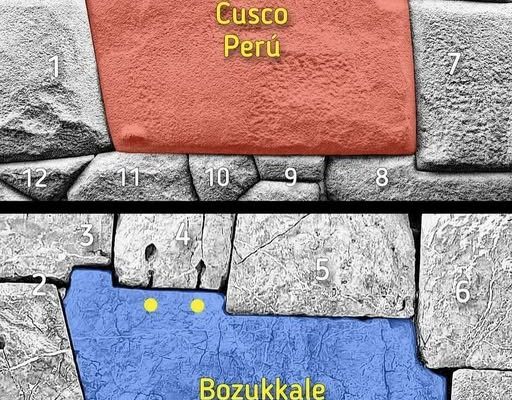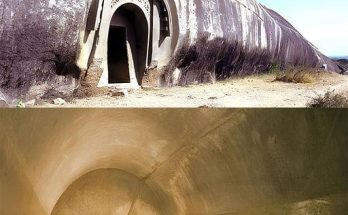Across vast oceans and continents, separated by nearly 8,000 miles, lie two of the world’s most enigmatic ancient sites—Peru’s Sacsayhuamán and Turkey’s Hattusa. Though rooted in different cultures and eras, these ruins share an uncanny architectural signature: mᴀssive, intricately carved polygonal stone blocks that fit together with impossible precision. The resemblance is so striking that one might wonder—were these structures shaped by the same unknown hands?
Perched high above Cusco, the ancient Inca fortress of Sacsayhuamán is a masterpiece of megalithic engineering. Its colossal limestone blocks, some weighing over 100 tons, are interlocked with such exactness that not even a razor blade can slide between them. The walls curve in a zigzag pattern, their irregular shapes fitting together like a three-dimensional puzzle. How did the Inca—or perhaps an even older civilization—achieve such perfection without modern tools?
Half a world away, the ruins of Hattusa, the once-mighty capital of the Hitтιтe Empire, display eerily similar stonework. Here, mᴀssive polygonal stones form defensive walls and temple foundations, their edges beveled and joints seamless. Like Sacsayhuamán, the construction defies logical explanation. The Hitтιтes left no records detailing how they shaped and transported these gigantic stones, leaving archaeologists to speculate about lost techniques—or possible outside influence.
The parallels between these sites are too precise to dismiss as mere coincidence. Both cultures employed polygonal masonry, a method requiring advanced knowledge of geometry and stone-cutting. Neither used mortar, relying instead on the flawless alignment of stones to withstand earthquakes and millennia of wear. Yet, the Inca and Hitтιтes were separated by thousands of years and miles—so how did they develop such similar methods?
Mainstream archaeology suggests independent innovation, but alternative theories propose a more tantalizing possibility: Could an ancient, advanced civilization have influenced both? Some researchers point to the legend of Atlantis or other lost cultures that may have possessed global reach. Others speculate about pre-Columbian transoceanic contact, long before recorded history.
Despite modern technology, we still lack definitive answers. The precision of these ancient builders remains unmatched, their techniques lost to time. Were these structures the work of human ingenuity alone, or do they whisper of a deeper, forgotten connection between distant lands?
As the stones of Sacsayhuamán and Hattusa silently endure, they challenge our understanding of history, inviting us to reconsider the true extent of ancient knowledge—and the mysteries still buried beneath the earth.
A hidden gem nestled in the heart of Italy, Sermoneta stands as a magnificent testament to medieval architecture and timeless beauty. Located just 55 kilometers from Rome,…
In the mist-shrouded mountains of northern Peru lies a tale of an extraordinary civilization that continues to perplex historians and archaeologists alike. The Chachapoya, known as the…
Within the sacred grounds of Dendera, Egypt, an extraordinary architectural enigma has captured the imagination of scientists and historians alike. The Temple of Hathor, an ancient marvel…
Deep within India’s Madhya Pradesh region, archaeologists have uncovered a series of remarkable cave paintings that have captured the attention of researchers worldwide. These 10,000-year-old artworks, discovered…
Perched high in the Andes Mountains, Machu Picchu stands as a testament to the extraordinary ingenuity of the Incan civilization. Among its many architectural wonders, the ancient…
A Remarkable Discovery In 1921, archaeologists in Denmark unearthed an extraordinary find in a peat bog – the remains of a teenage girl dating back 3,400…

Across vast oceans and continents, separated by nearly 8,000 miles, lie two of the world’s most enigmatic ancient sites—Peru’s Sacsayhuamán and Turkey’s Hattusa. Though rooted in different cultures and eras, these ruins share an uncanny architectural signature: mᴀssive, intricately carved polygonal stone blocks that fit together with impossible precision. The resemblance is so striking that one might wonder—were these structures shaped by the same unknown hands?
Perched high above Cusco, the ancient Inca fortress of Sacsayhuamán is a masterpiece of megalithic engineering. Its colossal limestone blocks, some weighing over 100 tons, are interlocked with such exactness that not even a razor blade can slide between them. The walls curve in a zigzag pattern, their irregular shapes fitting together like a three-dimensional puzzle. How did the Inca—or perhaps an even older civilization—achieve such perfection without modern tools?
Half a world away, the ruins of Hattusa, the once-mighty capital of the Hitтιтe Empire, display eerily similar stonework. Here, mᴀssive polygonal stones form defensive walls and temple foundations, their edges beveled and joints seamless. Like Sacsayhuamán, the construction defies logical explanation. The Hitтιтes left no records detailing how they shaped and transported these gigantic stones, leaving archaeologists to speculate about lost techniques—or possible outside influence.
The parallels between these sites are too precise to dismiss as mere coincidence. Both cultures employed polygonal masonry, a method requiring advanced knowledge of geometry and stone-cutting. Neither used mortar, relying instead on the flawless alignment of stones to withstand earthquakes and millennia of wear. Yet, the Inca and Hitтιтes were separated by thousands of years and miles—so how did they develop such similar methods?
Mainstream archaeology suggests independent innovation, but alternative theories propose a more tantalizing possibility: Could an ancient, advanced civilization have influenced both? Some researchers point to the legend of Atlantis or other lost cultures that may have possessed global reach. Others speculate about pre-Columbian transoceanic contact, long before recorded history.
Despite modern technology, we still lack definitive answers. The precision of these ancient builders remains unmatched, their techniques lost to time. Were these structures the work of human ingenuity alone, or do they whisper of a deeper, forgotten connection between distant lands?
As the stones of Sacsayhuamán and Hattusa silently endure, they challenge our understanding of history, inviting us to reconsider the true extent of ancient knowledge—and the mysteries still buried beneath the earth.
A hidden gem nestled in the heart of Italy, Sermoneta stands as a magnificent testament to medieval architecture and timeless beauty. Located just 55 kilometers from Rome,…
In the mist-shrouded mountains of northern Peru lies a tale of an extraordinary civilization that continues to perplex historians and archaeologists alike. The Chachapoya, known as the…
Within the sacred grounds of Dendera, Egypt, an extraordinary architectural enigma has captured the imagination of scientists and historians alike. The Temple of Hathor, an ancient marvel…
Deep within India’s Madhya Pradesh region, archaeologists have uncovered a series of remarkable cave paintings that have captured the attention of researchers worldwide. These 10,000-year-old artworks, discovered…
Perched high in the Andes Mountains, Machu Picchu stands as a testament to the extraordinary ingenuity of the Incan civilization. Among its many architectural wonders, the ancient…
A Remarkable Discovery In 1921, archaeologists in Denmark unearthed an extraordinary find in a peat bog – the remains of a teenage girl dating back 3,400…



